MGMT2016 - Business Demographics: NSW Population Growth Report
VerifiedAdded on 2022/07/28
|8
|1890
|17
Report
AI Summary
This report examines the population growth in New South Wales (NSW) from 2006 to 2016, analyzing the trends and key components of population change, including natural increase, overseas migration, and interstate migration. The analysis reveals significant population growth, particularly in Sydney and coastal regions, and discusses the factors contributing to this growth, such as birth and death rates, migration patterns, and urbanization. Furthermore, the report explores the impact of these demographic shifts on the business environment in NSW, focusing on changes in the labor market, shifts in consumer preferences, and the need for businesses to adapt to technological trends and customer demands. The report uses data from the Australian Bureau of Statistics (ABS) and other sources to support its findings, concluding that population change significantly influences business operations, requiring organizations to adapt their strategies to remain competitive and sustainable.
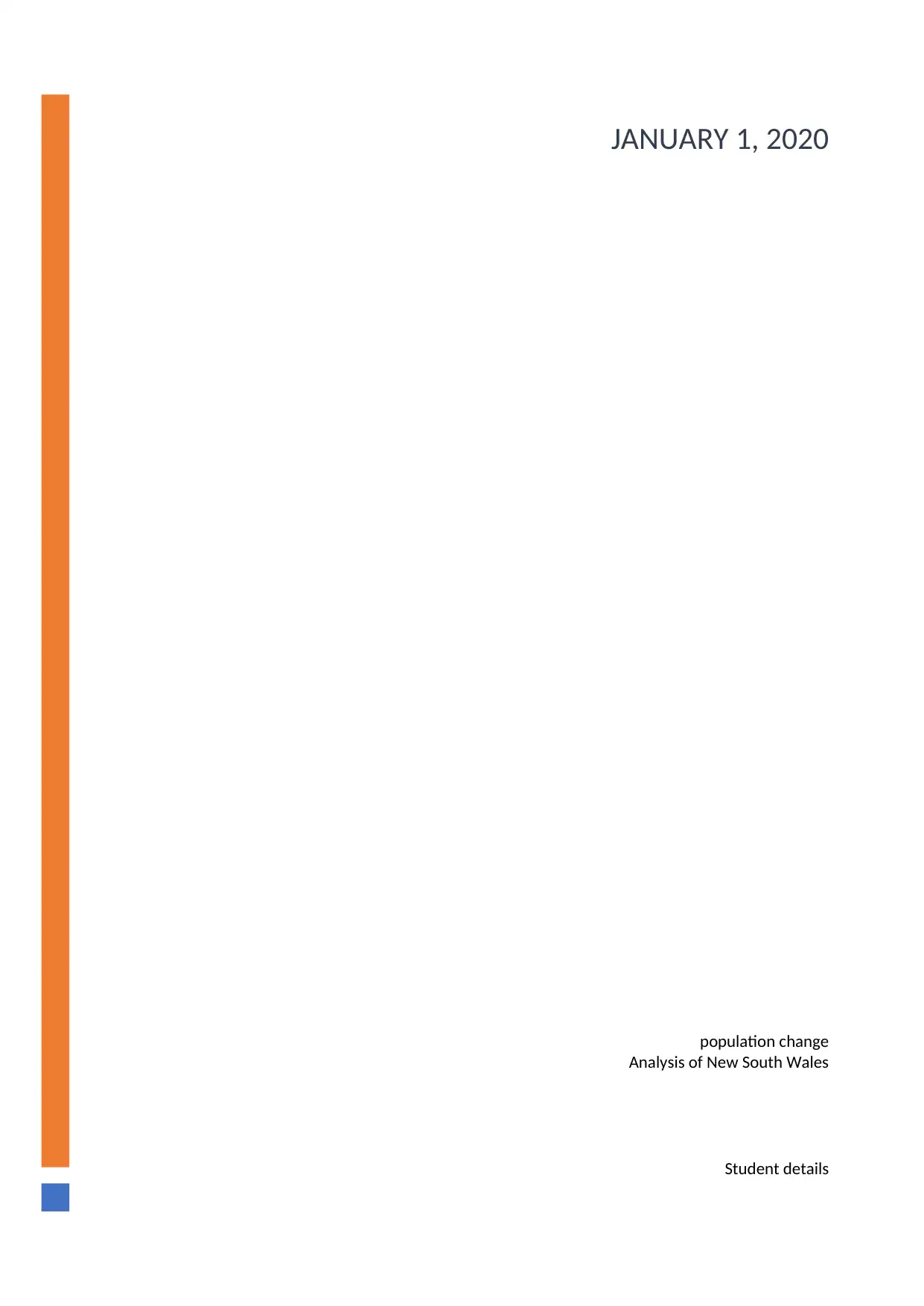
population change
Analysis of New South Wales
Student details
JANUARY 1, 2020
Analysis of New South Wales
Student details
JANUARY 1, 2020
Paraphrase This Document
Need a fresh take? Get an instant paraphrase of this document with our AI Paraphraser
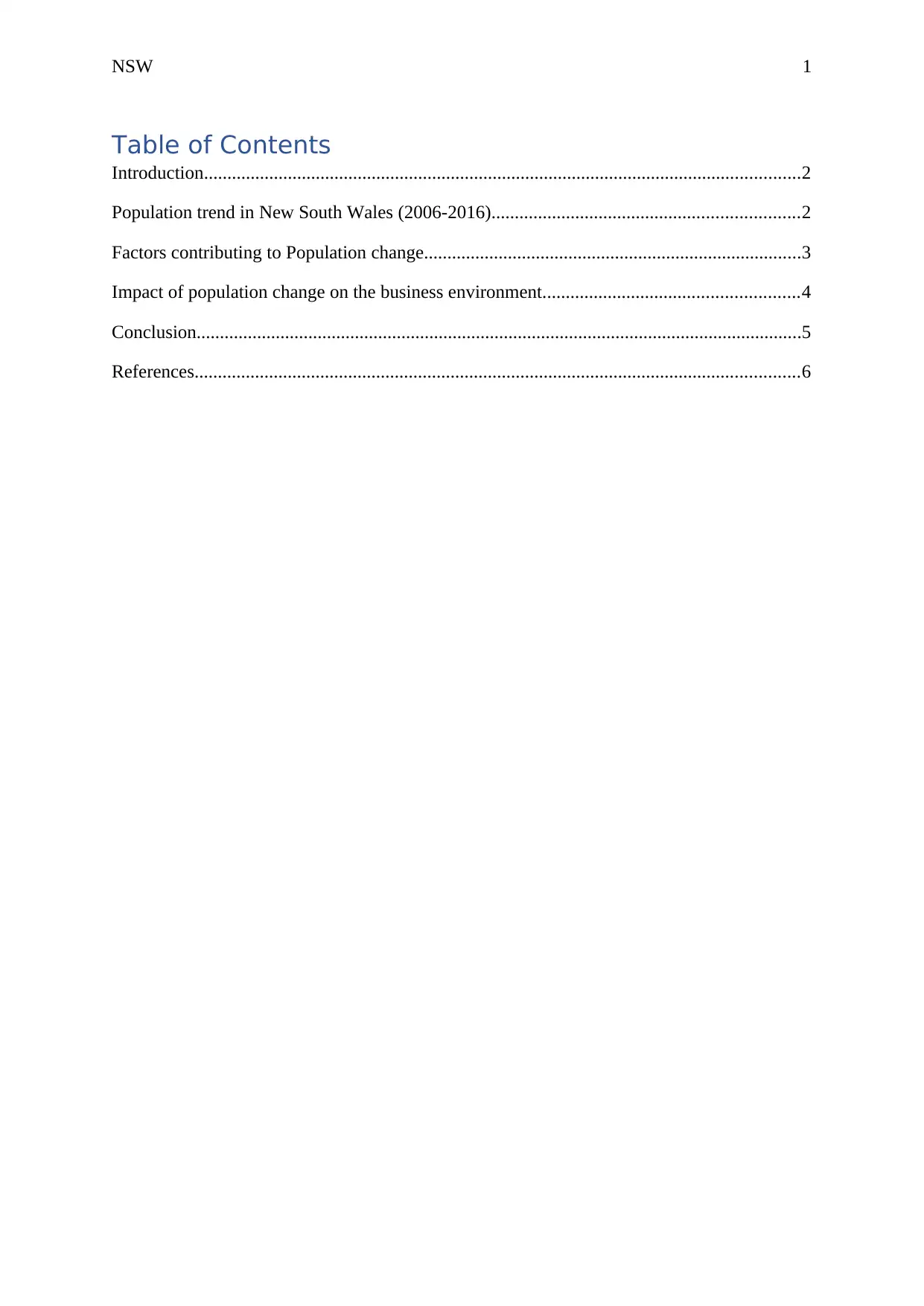
NSW 1
Table of Contents
Introduction................................................................................................................................2
Population trend in New South Wales (2006-2016)..................................................................2
Factors contributing to Population change.................................................................................3
Impact of population change on the business environment.......................................................4
Conclusion..................................................................................................................................5
References..................................................................................................................................6
Table of Contents
Introduction................................................................................................................................2
Population trend in New South Wales (2006-2016)..................................................................2
Factors contributing to Population change.................................................................................3
Impact of population change on the business environment.......................................................4
Conclusion..................................................................................................................................5
References..................................................................................................................................6
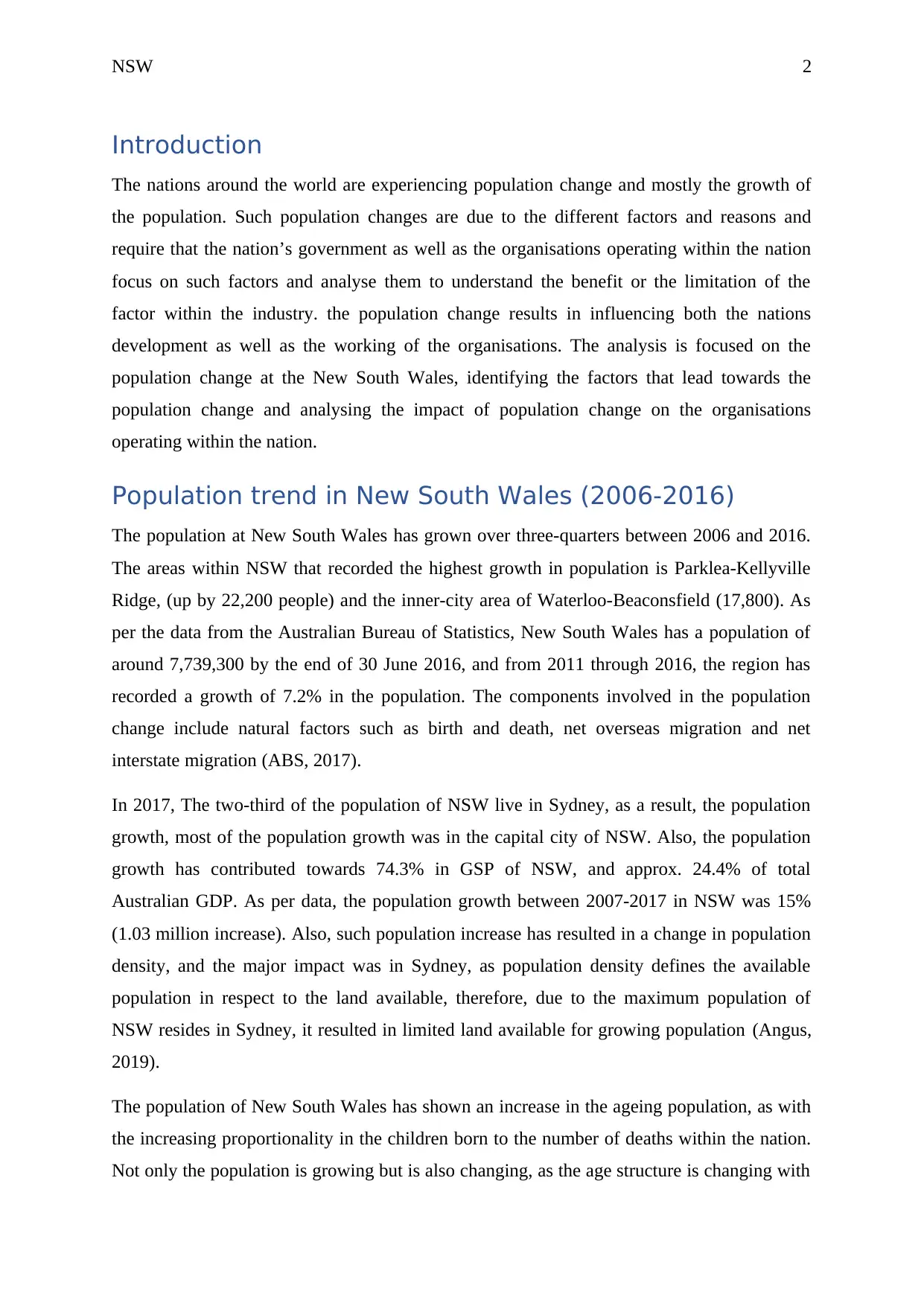
NSW 2
Introduction
The nations around the world are experiencing population change and mostly the growth of
the population. Such population changes are due to the different factors and reasons and
require that the nation’s government as well as the organisations operating within the nation
focus on such factors and analyse them to understand the benefit or the limitation of the
factor within the industry. the population change results in influencing both the nations
development as well as the working of the organisations. The analysis is focused on the
population change at the New South Wales, identifying the factors that lead towards the
population change and analysing the impact of population change on the organisations
operating within the nation.
Population trend in New South Wales (2006-2016)
The population at New South Wales has grown over three-quarters between 2006 and 2016.
The areas within NSW that recorded the highest growth in population is Parklea-Kellyville
Ridge, (up by 22,200 people) and the inner-city area of Waterloo-Beaconsfield (17,800). As
per the data from the Australian Bureau of Statistics, New South Wales has a population of
around 7,739,300 by the end of 30 June 2016, and from 2011 through 2016, the region has
recorded a growth of 7.2% in the population. The components involved in the population
change include natural factors such as birth and death, net overseas migration and net
interstate migration (ABS, 2017).
In 2017, The two-third of the population of NSW live in Sydney, as a result, the population
growth, most of the population growth was in the capital city of NSW. Also, the population
growth has contributed towards 74.3% in GSP of NSW, and approx. 24.4% of total
Australian GDP. As per data, the population growth between 2007-2017 in NSW was 15%
(1.03 million increase). Also, such population increase has resulted in a change in population
density, and the major impact was in Sydney, as population density defines the available
population in respect to the land available, therefore, due to the maximum population of
NSW resides in Sydney, it resulted in limited land available for growing population (Angus,
2019).
The population of New South Wales has shown an increase in the ageing population, as with
the increasing proportionality in the children born to the number of deaths within the nation.
Not only the population is growing but is also changing, as the age structure is changing with
Introduction
The nations around the world are experiencing population change and mostly the growth of
the population. Such population changes are due to the different factors and reasons and
require that the nation’s government as well as the organisations operating within the nation
focus on such factors and analyse them to understand the benefit or the limitation of the
factor within the industry. the population change results in influencing both the nations
development as well as the working of the organisations. The analysis is focused on the
population change at the New South Wales, identifying the factors that lead towards the
population change and analysing the impact of population change on the organisations
operating within the nation.
Population trend in New South Wales (2006-2016)
The population at New South Wales has grown over three-quarters between 2006 and 2016.
The areas within NSW that recorded the highest growth in population is Parklea-Kellyville
Ridge, (up by 22,200 people) and the inner-city area of Waterloo-Beaconsfield (17,800). As
per the data from the Australian Bureau of Statistics, New South Wales has a population of
around 7,739,300 by the end of 30 June 2016, and from 2011 through 2016, the region has
recorded a growth of 7.2% in the population. The components involved in the population
change include natural factors such as birth and death, net overseas migration and net
interstate migration (ABS, 2017).
In 2017, The two-third of the population of NSW live in Sydney, as a result, the population
growth, most of the population growth was in the capital city of NSW. Also, the population
growth has contributed towards 74.3% in GSP of NSW, and approx. 24.4% of total
Australian GDP. As per data, the population growth between 2007-2017 in NSW was 15%
(1.03 million increase). Also, such population increase has resulted in a change in population
density, and the major impact was in Sydney, as population density defines the available
population in respect to the land available, therefore, due to the maximum population of
NSW resides in Sydney, it resulted in limited land available for growing population (Angus,
2019).
The population of New South Wales has shown an increase in the ageing population, as with
the increasing proportionality in the children born to the number of deaths within the nation.
Not only the population is growing but is also changing, as the age structure is changing with
⊘ This is a preview!⊘
Do you want full access?
Subscribe today to unlock all pages.

Trusted by 1+ million students worldwide

NSW 3
an increase in the younger age participants, and accordingly, the needs and demands within
the industry are emerging. The increase in the number of people willing to work and the
number of employment opportunities available within the industry has also developed within
the region. However, the growth in the region was not evenly distributed, the coastal regions
experienced rapid growth as compared to other regions (Biddle, et al., 2018).
Factors contributing to Population change
The major factors that have contributed towards the change in the population are natural
increase and the migration. The natural increase is defined the number of births in respect to
the number of deaths within the region, such factor has contributed towards the population
change within the nation and has resulted in the population growth. The nation has effectively
adopted the technological changes and has introduced several health benefits which have
controlled the number of deaths and have added towards the reason behind the population
increase at New South Wales. There are certainly other factors apart from the birth and death
rates, which are required to be considered in order to identify the net impact on the
population growth within the nation.
The overseas migration and interstate immigration are also major factors that have
contributed to the growth of the population within the state. As across the time period, net
overseas migration has contributed towards 53.2% growth in the population of the region of
new south wales. As compared to the natural factors, migration has contributed towards the
maximum change. The migrants within new south wales include the students who have
arrived through temporary visa, permanent visa holders that includes the skilled workers,
family visas, and the persons who have special eligibility. Between the period od f 2006-
2016, the number of the visa issues were around four to five times more than the visa
approval given in the past (Id, 2020).
As it can be reflected that the migration or the immigration is occurring due to the availability
of better and developed resource within the region, and due to the urbanisation, and with the
increasing urbanisation, the peoples are moving into the city with a focus towards better life
development and for a better and improved lifestyle. The population change can be analysed
using the demographic theory which explains that there are certain stages which define the
population change within the nation. The natural factor analysis results that the region has
more or increasing population of older age groups, as compared to those of below 15 age.
The population is impacted majorly by the immigrants within the region and has resulted in
an increase in the younger age participants, and accordingly, the needs and demands within
the industry are emerging. The increase in the number of people willing to work and the
number of employment opportunities available within the industry has also developed within
the region. However, the growth in the region was not evenly distributed, the coastal regions
experienced rapid growth as compared to other regions (Biddle, et al., 2018).
Factors contributing to Population change
The major factors that have contributed towards the change in the population are natural
increase and the migration. The natural increase is defined the number of births in respect to
the number of deaths within the region, such factor has contributed towards the population
change within the nation and has resulted in the population growth. The nation has effectively
adopted the technological changes and has introduced several health benefits which have
controlled the number of deaths and have added towards the reason behind the population
increase at New South Wales. There are certainly other factors apart from the birth and death
rates, which are required to be considered in order to identify the net impact on the
population growth within the nation.
The overseas migration and interstate immigration are also major factors that have
contributed to the growth of the population within the state. As across the time period, net
overseas migration has contributed towards 53.2% growth in the population of the region of
new south wales. As compared to the natural factors, migration has contributed towards the
maximum change. The migrants within new south wales include the students who have
arrived through temporary visa, permanent visa holders that includes the skilled workers,
family visas, and the persons who have special eligibility. Between the period od f 2006-
2016, the number of the visa issues were around four to five times more than the visa
approval given in the past (Id, 2020).
As it can be reflected that the migration or the immigration is occurring due to the availability
of better and developed resource within the region, and due to the urbanisation, and with the
increasing urbanisation, the peoples are moving into the city with a focus towards better life
development and for a better and improved lifestyle. The population change can be analysed
using the demographic theory which explains that there are certain stages which define the
population change within the nation. The natural factor analysis results that the region has
more or increasing population of older age groups, as compared to those of below 15 age.
The population is impacted majorly by the immigrants within the region and has resulted in
Paraphrase This Document
Need a fresh take? Get an instant paraphrase of this document with our AI Paraphraser
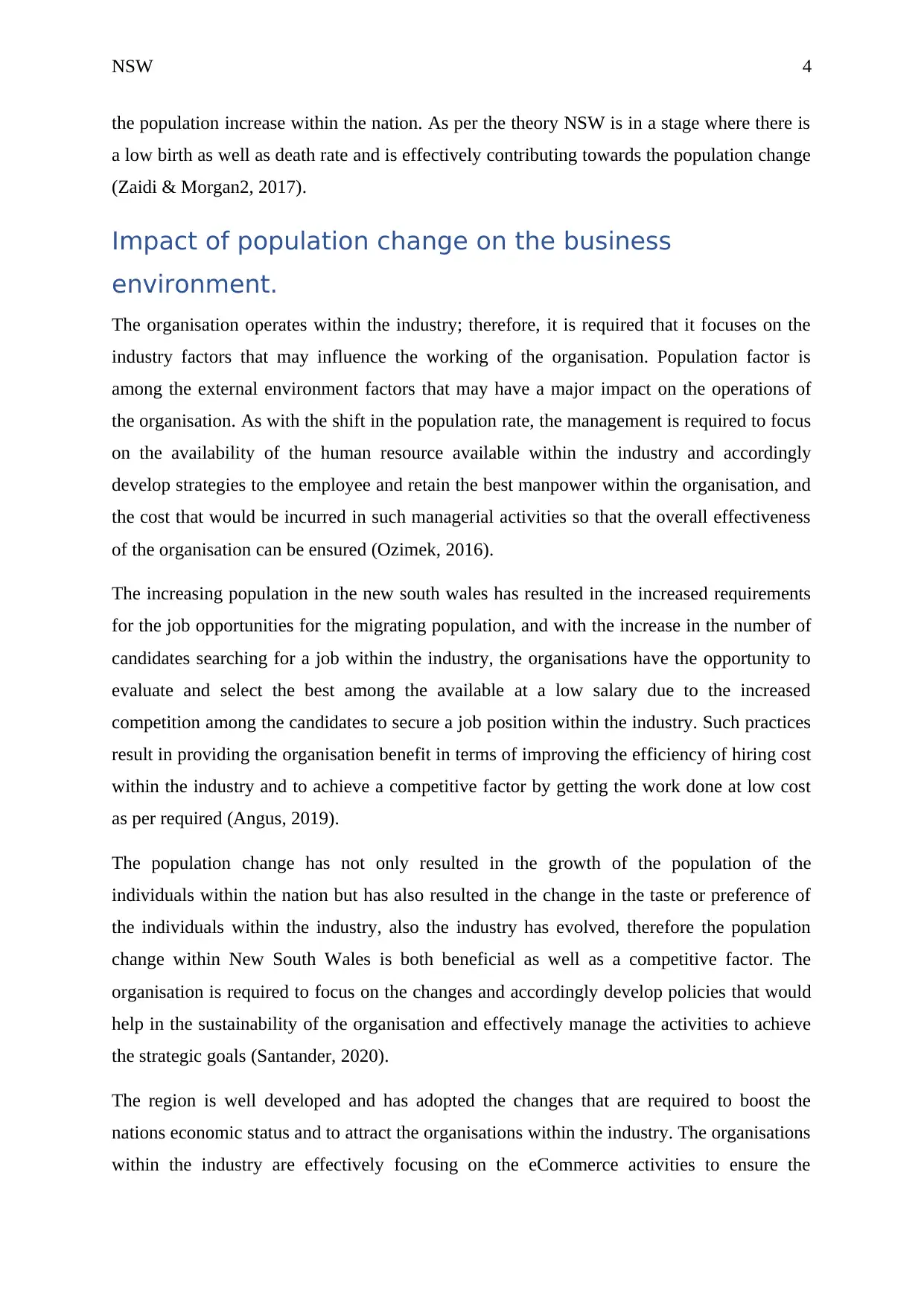
NSW 4
the population increase within the nation. As per the theory NSW is in a stage where there is
a low birth as well as death rate and is effectively contributing towards the population change
(Zaidi & Morgan2, 2017).
Impact of population change on the business
environment.
The organisation operates within the industry; therefore, it is required that it focuses on the
industry factors that may influence the working of the organisation. Population factor is
among the external environment factors that may have a major impact on the operations of
the organisation. As with the shift in the population rate, the management is required to focus
on the availability of the human resource available within the industry and accordingly
develop strategies to the employee and retain the best manpower within the organisation, and
the cost that would be incurred in such managerial activities so that the overall effectiveness
of the organisation can be ensured (Ozimek, 2016).
The increasing population in the new south wales has resulted in the increased requirements
for the job opportunities for the migrating population, and with the increase in the number of
candidates searching for a job within the industry, the organisations have the opportunity to
evaluate and select the best among the available at a low salary due to the increased
competition among the candidates to secure a job position within the industry. Such practices
result in providing the organisation benefit in terms of improving the efficiency of hiring cost
within the industry and to achieve a competitive factor by getting the work done at low cost
as per required (Angus, 2019).
The population change has not only resulted in the growth of the population of the
individuals within the nation but has also resulted in the change in the taste or preference of
the individuals within the industry, also the industry has evolved, therefore the population
change within New South Wales is both beneficial as well as a competitive factor. The
organisation is required to focus on the changes and accordingly develop policies that would
help in the sustainability of the organisation and effectively manage the activities to achieve
the strategic goals (Santander, 2020).
The region is well developed and has adopted the changes that are required to boost the
nations economic status and to attract the organisations within the industry. The organisations
within the industry are effectively focusing on the eCommerce activities to ensure the
the population increase within the nation. As per the theory NSW is in a stage where there is
a low birth as well as death rate and is effectively contributing towards the population change
(Zaidi & Morgan2, 2017).
Impact of population change on the business
environment.
The organisation operates within the industry; therefore, it is required that it focuses on the
industry factors that may influence the working of the organisation. Population factor is
among the external environment factors that may have a major impact on the operations of
the organisation. As with the shift in the population rate, the management is required to focus
on the availability of the human resource available within the industry and accordingly
develop strategies to the employee and retain the best manpower within the organisation, and
the cost that would be incurred in such managerial activities so that the overall effectiveness
of the organisation can be ensured (Ozimek, 2016).
The increasing population in the new south wales has resulted in the increased requirements
for the job opportunities for the migrating population, and with the increase in the number of
candidates searching for a job within the industry, the organisations have the opportunity to
evaluate and select the best among the available at a low salary due to the increased
competition among the candidates to secure a job position within the industry. Such practices
result in providing the organisation benefit in terms of improving the efficiency of hiring cost
within the industry and to achieve a competitive factor by getting the work done at low cost
as per required (Angus, 2019).
The population change has not only resulted in the growth of the population of the
individuals within the nation but has also resulted in the change in the taste or preference of
the individuals within the industry, also the industry has evolved, therefore the population
change within New South Wales is both beneficial as well as a competitive factor. The
organisation is required to focus on the changes and accordingly develop policies that would
help in the sustainability of the organisation and effectively manage the activities to achieve
the strategic goals (Santander, 2020).
The region is well developed and has adopted the changes that are required to boost the
nations economic status and to attract the organisations within the industry. The organisations
within the industry are effectively focusing on the eCommerce activities to ensure the

NSW 5
fulfilment of the customer’s needs and requirements within the industry. As the population
growth within the region of new south wales is attracted towards the technological trends and
focus on the organisations that are providing with the online as well as quality services within
the industry. Also, the customers require that the organisations provide them with the creative
and innovative products within the industry (Australia Post, 2019).
Conclusion
New South Wales has effectively experienced a population growth within the region and
most specifically in the coastal regions as well as in Sydney. The population change has been
a result of the change in the birth and the death rates and the migration of the individuals in
search for study, job or a better lifestyle. The population has effectively grown in the region
due to the urbanisation and the adaption of the technology in various aspects. As a result of
the population change, the organisations within the industry are changing the way they used
to conduct business activities. The growth in population has resulted in providing the
organisations with more options within the industry to select the required human resource.
The population change has also resulted in shifting of customer’s taste and preference within
the industry, and accordingly requires that the organisations focus on such aspects to ensure
their sustainability within the industry.
fulfilment of the customer’s needs and requirements within the industry. As the population
growth within the region of new south wales is attracted towards the technological trends and
focus on the organisations that are providing with the online as well as quality services within
the industry. Also, the customers require that the organisations provide them with the creative
and innovative products within the industry (Australia Post, 2019).
Conclusion
New South Wales has effectively experienced a population growth within the region and
most specifically in the coastal regions as well as in Sydney. The population change has been
a result of the change in the birth and the death rates and the migration of the individuals in
search for study, job or a better lifestyle. The population has effectively grown in the region
due to the urbanisation and the adaption of the technology in various aspects. As a result of
the population change, the organisations within the industry are changing the way they used
to conduct business activities. The growth in population has resulted in providing the
organisations with more options within the industry to select the required human resource.
The population change has also resulted in shifting of customer’s taste and preference within
the industry, and accordingly requires that the organisations focus on such aspects to ensure
their sustainability within the industry.
⊘ This is a preview!⊘
Do you want full access?
Subscribe today to unlock all pages.

Trusted by 1+ million students worldwide
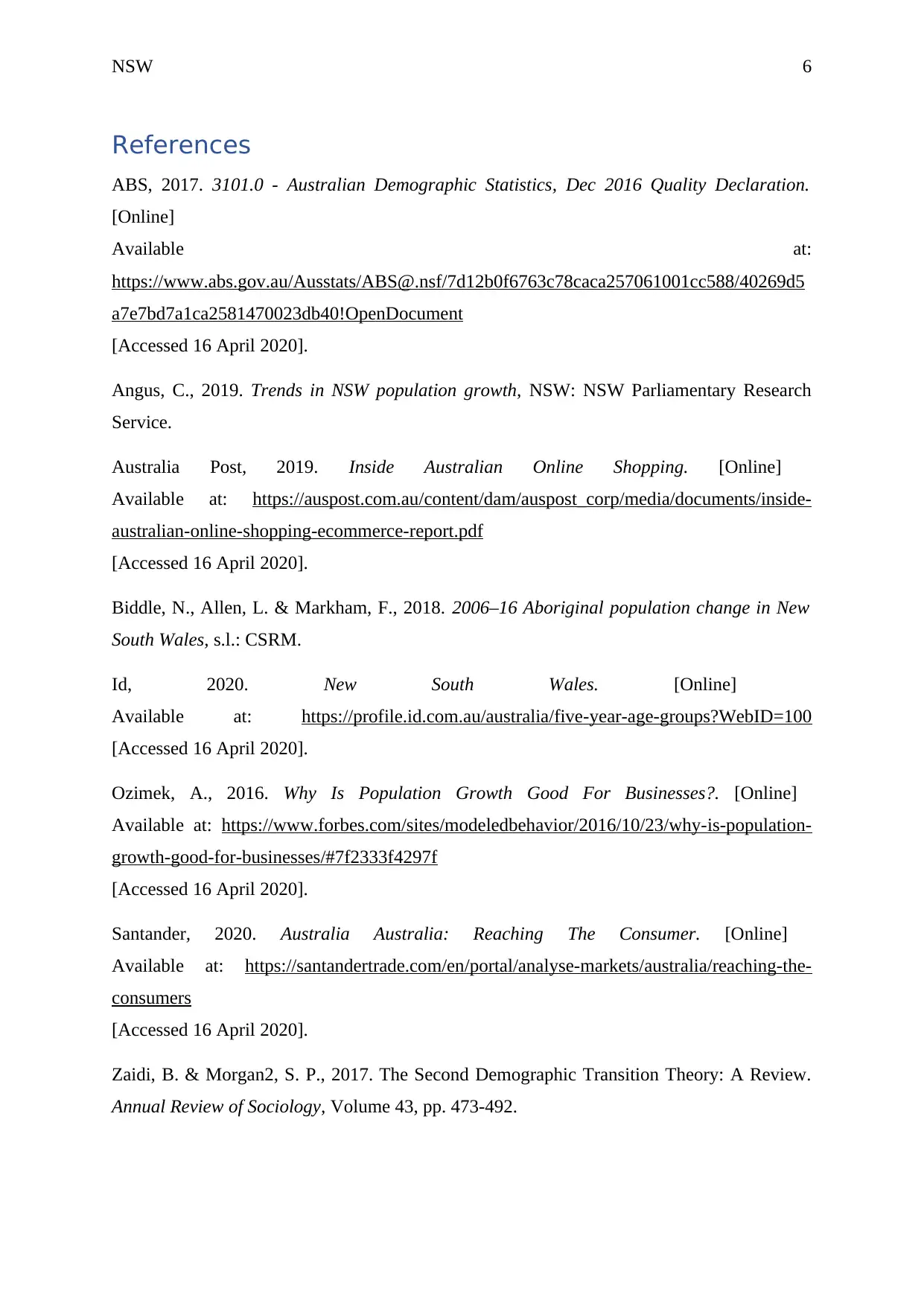
NSW 6
References
ABS, 2017. 3101.0 - Australian Demographic Statistics, Dec 2016 Quality Declaration.
[Online]
Available at:
https://www.abs.gov.au/Ausstats/ABS@.nsf/7d12b0f6763c78caca257061001cc588/40269d5
a7e7bd7a1ca2581470023db40!OpenDocument
[Accessed 16 April 2020].
Angus, C., 2019. Trends in NSW population growth, NSW: NSW Parliamentary Research
Service.
Australia Post, 2019. Inside Australian Online Shopping. [Online]
Available at: https://auspost.com.au/content/dam/auspost_corp/media/documents/inside-
australian-online-shopping-ecommerce-report.pdf
[Accessed 16 April 2020].
Biddle, N., Allen, L. & Markham, F., 2018. 2006–16 Aboriginal population change in New
South Wales, s.l.: CSRM.
Id, 2020. New South Wales. [Online]
Available at: https://profile.id.com.au/australia/five-year-age-groups?WebID=100
[Accessed 16 April 2020].
Ozimek, A., 2016. Why Is Population Growth Good For Businesses?. [Online]
Available at: https://www.forbes.com/sites/modeledbehavior/2016/10/23/why-is-population-
growth-good-for-businesses/#7f2333f4297f
[Accessed 16 April 2020].
Santander, 2020. Australia Australia: Reaching The Consumer. [Online]
Available at: https://santandertrade.com/en/portal/analyse-markets/australia/reaching-the-
consumers
[Accessed 16 April 2020].
Zaidi, B. & Morgan2, S. P., 2017. The Second Demographic Transition Theory: A Review.
Annual Review of Sociology, Volume 43, pp. 473-492.
References
ABS, 2017. 3101.0 - Australian Demographic Statistics, Dec 2016 Quality Declaration.
[Online]
Available at:
https://www.abs.gov.au/Ausstats/ABS@.nsf/7d12b0f6763c78caca257061001cc588/40269d5
a7e7bd7a1ca2581470023db40!OpenDocument
[Accessed 16 April 2020].
Angus, C., 2019. Trends in NSW population growth, NSW: NSW Parliamentary Research
Service.
Australia Post, 2019. Inside Australian Online Shopping. [Online]
Available at: https://auspost.com.au/content/dam/auspost_corp/media/documents/inside-
australian-online-shopping-ecommerce-report.pdf
[Accessed 16 April 2020].
Biddle, N., Allen, L. & Markham, F., 2018. 2006–16 Aboriginal population change in New
South Wales, s.l.: CSRM.
Id, 2020. New South Wales. [Online]
Available at: https://profile.id.com.au/australia/five-year-age-groups?WebID=100
[Accessed 16 April 2020].
Ozimek, A., 2016. Why Is Population Growth Good For Businesses?. [Online]
Available at: https://www.forbes.com/sites/modeledbehavior/2016/10/23/why-is-population-
growth-good-for-businesses/#7f2333f4297f
[Accessed 16 April 2020].
Santander, 2020. Australia Australia: Reaching The Consumer. [Online]
Available at: https://santandertrade.com/en/portal/analyse-markets/australia/reaching-the-
consumers
[Accessed 16 April 2020].
Zaidi, B. & Morgan2, S. P., 2017. The Second Demographic Transition Theory: A Review.
Annual Review of Sociology, Volume 43, pp. 473-492.
Paraphrase This Document
Need a fresh take? Get an instant paraphrase of this document with our AI Paraphraser

NSW 7
1 out of 8
Related Documents
Your All-in-One AI-Powered Toolkit for Academic Success.
+13062052269
info@desklib.com
Available 24*7 on WhatsApp / Email
![[object Object]](/_next/static/media/star-bottom.7253800d.svg)
Unlock your academic potential
Copyright © 2020–2025 A2Z Services. All Rights Reserved. Developed and managed by ZUCOL.




